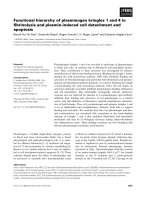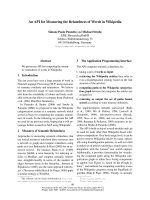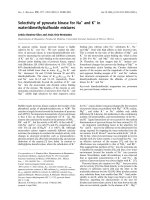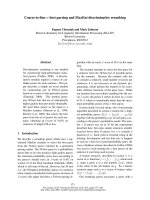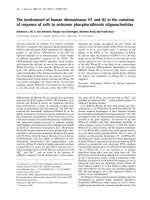báo cáo khoa học: " Love as harm reduction: fighting AIDS and stigma in Vietnam" docx
Bạn đang xem bản rút gọn của tài liệu. Xem và tải ngay bản đầy đủ của tài liệu tại đây (426.18 KB, 5 trang )
BioMed Central
Page 1 of 5
(page number not for citation purposes)
Harm Reduction Journal
Open Access
Case study
Love as harm reduction: fighting AIDS and stigma in Vietnam
Dan Small
1,2
Address:
1
Department of Anthropology, University of British Columbia, Vancouver, Canada and
2
Director, PHS Community Services Society,
Vancouver, Canada
Email: Dan Small -
Abstract
In the summer of 2009, I visited a humble orphanage for children with HIV/AIDS in Vietnam. Here,
like many parts in the world, the very existence of marginalized people with stigmatized illness is
hidden away. Relegated to the shadows of society, these children lacked something more
fundamental than housing, shelter, nutrition and medications. They lacked families to love and care
for them unconditionally. One might think it self-evident that a visit to an orphanage for children
with HIV would be profound, but the profundity wasn't where I expected to find it. It was in how
the children had created their own family, loving each other like brothers and sisters, and the way
the priest who operated the shelters was more than a Father, he was a dad to dozens of children.
This is an account of love as harm reduction in the Mai Tam orphanage in Ho Chi Minh City.
For Bé Hin
The Mai Tam orphanage and two other shelters in Ho Chi
Minh City are operated under the direction of a Catholic
priest, Father Toai Dinh Toai in the Archdiocese of Ho Chi
Minh City. The first is home to 50 children and 14 moth-
ers with HIV and AIDS. It is known as the Mai Tam shelter.
The second provides shelter for 26 children and 12 moth-
ers living with HIV. The third is a hospice where there are
currently 16 children in the doorway of death. The priest
who operates the shelter is a young man with gentleness
in his eyes and a welcoming smile. When I walked with
him from room to room, the children reached to touch
him like they might a loving mother or father. As a father
myself, the love between the children and their collective
dad was unmistakable.
Ensuring that the children have shelter is no small task.
The program is controversial in Vietnam and there is tre-
mendous difficulty finding a permanent place where chil-
dren with HIV are welcome. When I visited, the priest and
the children were illegally "squatting" in a home after
being served eviction by the owner of the home. Despite
visits from the police at the request of the landlord, Fr.
Toai was holding out until there was a new home for the
orphans. Fortunately, a parishioner had donated half of
her yard for a shelter and the money had been raised to
build a permanent home.
Beyond being a priest, Fr. Toai has undergone training to
become a physician's assistant. This allows him to go
beyond overseeing the children's shelter and psychosocial
needs to managing their health care (including anti-retro-
viral treatment). Each day, he begins at 6:30 am as he vis-
its the shelters one after another. His day ends at 10:00
each evening after visiting the children's hospice. He has
the help of nuns who provide schooling and nurses that
visit during the week. Mothers with HIV living in the shel-
ter also help with the care of the children.
Whenever possible, Fr. Toai attempts to reconnect the
children with any surviving family members. This is
extremely difficult and requires educational tenacity as he
Published: 3 December 2009
Harm Reduction Journal 2009, 6:34 doi:10.1186/1477-7517-6-34
Received: 23 September 2009
Accepted: 3 December 2009
This article is available from: />© 2009 Small; licensee BioMed Central Ltd.
This is an Open Access article distributed under the terms of the Creative Commons Attribution License ( />),
which permits unrestricted use, distribution, and reproduction in any medium, provided the original work is properly cited.
Harm Reduction Journal 2009, 6:34 />Page 2 of 5
(page number not for citation purposes)
works to overcome stigma, fear and lack of knowledge
about HIV. He also tries to reintegrate them into main-
stream society. This is an enormous challenge given that
children with HIV are not even welcome in schools in Ho
Chi Minh City. As the school year began in 2009, parents
of unaffected children forced officials, who willingly com-
plied, to expel all children living with HIV. The newspa-
pers carried photographs of children with HIV, with tears
streaming down their cheeks, ashamedly exiting the
schools on the first day of class[1,2].
The priest told me that one of the girls he was trying to
integrate into a mainstream school asked him a penetrat-
ing question one day: "how come you teach me not to lie,
but you tell me to lie at school?" He had instructed her to
avoid telling other children that she has HIV when she has
to take her antiretroviral medications (ARVs). Instead, he
had suggested that she say that she has a heart problem.
Clearly, the priest understood that the children do not live
in the black and white world of the Ten Commandments.
My impression upon seeing dozens of children in the
crowded shelter was a mixture of sadness and rage. My
sadness had the same roots as my ire at how we had failed
these children. We had failed to put in place the necessary
healthcare and social conditions to protect them from
contracting HIV. Here these children were, and still are,
sequestered from streets of Ho Chi Minh City where their
pain might otherwise be publicly acknowledged. They
had arrived at the orphanage with the death of their par-
ents or they had been abandoned, deserted and left at the
doorstep. Without this modest shelter, they would lack of
the basic sustenance necessary to give them the slightest
chance at health. But there was something deeply inspir-
ing about this shelter from the cold world.
Life at Mai Tam
At the shelter, the children appeared, for the most part, to
be happy. They were drawn to the young priest as though
he were their paternal father. I watched as a little one,
withered with his illness and as of yet unresponsive to
treatment, 7 years old and no more than 30 pounds,
weakly reached up from the floor where he sat to touch
the Father's hand. The father attentively caressed his little
wrist and held onto his little arm with love (see Figure 1).
He introduced each child and told his or her story. The
young ones signaled their desire to be picked up and held
by him by lifting their little arms in the air as he drew near.
When he first began speaking, one little boy of about 11
months of age crawled over to the father and tugged at his
leg. The Father bent down and picked him up and held
him like his own son. One of the young mothers with HIV
who live and help in the orphanage reached to hold the
baby so that the priest could continue his tour. The little
boy clung and protested with big wet tears and cried out
for the priest when the young mother took him. It
reminded me of my own son at home in Canada, the
same age, desperately reaching for me whenever I walk
into the room.
The youngest children were in a playroom at naptime
when I arrived. They slept on the floor in a room while
two young women from the shelter watched over them.
There is only one bathroom, with a single shower hose
and a bucket, which is used to bath the children. They
have donated formula, anti-retroviral HIV medication
and some toys. Each child has their own face cloth with
their name written on it hanging on a drying rack in the
room. The environment, though sparse, appeared to be
infused with love, caring and kindness. This love seemed,
to me, to be the core ingredient in the healthcare and
housing of these children. Without it, I'm convinced; they
wouldn't stand a chance to be on the threshold of a suc-
cessful life.
The youngest child was a small baby of only a few months
who was unable to hold her own bottle. She was aban-
doned in the hospital and was too little to hold her own
bottle so one was propped in her mouth. As I looked at
her in her small crib, she looked at my face and followed
me with her eyes. As one of the young boys began to cry,
Fr. Toai walked over to him and asked why he was sad.
The little boy told him that another boy had taken his toy.
The priest went over to the other child and softly asked for
the toy to be given back. The little boy handed the toy to
the father and he returned it. The sad boy immediately
stopped crying. His "dad" had set the situation right.
The EmbraceFigure 1
The Embrace. A photograph of a loving embrace between
a father and son.
Harm Reduction Journal 2009, 6:34 />Page 3 of 5
(page number not for citation purposes)
Children teaching kindness
One of the things that was most profound to me was the
fact that the children had so much to teach about kind-
ness. It was a kindness that had not been given to them
from the wider world from where they had been expelled.
As a case in point, a young girl, of about 6 years of age, car-
ried the children around the room, took them from the
priest to help him. She would then sit down with them on
her lap and stroke their hair and kiss them. One little boy,
about 13 months old, provided a lesson in sharing. He
was sitting holding his infant bottle and trying to feed
another child of the same age. The other child did not
want to eat but the little caregiver was persistent. Finally,
the little boy took some of the milk: one little baby feed-
ing another. The recipient of the bottle eventually pushed
the bottle out of his mouth. The caregiver persistently
attempted to feed his little friend again, about 3-dozen
tries, each time saying "Uh Uh, pause, Uh Uh, pause, Uh
Uh". The little recipient began to cry and the nurturer
stroked his head and consoled him in Vietnamese. Here,
were two infants, not yet walking, sharing their scarce
food and taking care of each other. When I commented on
this, the priest said that the young children had not yet
been exposed to the wider world and, as such, have not
met people who are so concerned about meeting their
own needs. Like brothers and sisters, they had created the
love and family none of them had outside the orphanage.
But, despite the lesson they taught about kindness and
acceptance, they still have to share the finite amount of
parental love available through the father, the nuns and ill
mothers. They appeared to me to crave human contact
and more than once I felt one of the children brush
against my leg and tug on my pant leg to be picked up.
When I photographed them, they ran to me to see the dig-
ital image. One child, the priest sadly showed us, is iso-
lated because he has tuberculosis. He has to spend all his
days and nights, alone, in a single room behind glass win-
dows. I wished that prospective parents would open their
hearts a little wider and adopt children with HIV. But, as
a rule, they don't.
One of the young children, a boy of about 2 years of age,
it turned out, in the fullness of time, was not HIV positive.
The priest reported that a Canadian couple attempted to
adopt him but have given up after the process appeared
too difficult. I asked the Priest if adoption would be ulti-
mately completed: he stated "No, not this time". The little
boy slept, without a pillow, on his side on the floor. Ear-
lier a five-year-old girl had held him on her lap and picked
him up so that his head was on her shoulder. He proved a
little too heavy, while sleeping, and, as a result, his head
would roll back and his light hair would hang down-
wards.
A powerful history of stigma
The stigma against HIV in Vietnam is powerful. The owner
of the home where the majority of orphans lived when I
visited wanted the house back. The owner had evicted
them despite the fact that they did not have another home
where they could live. The Priest has had to raise
$200,000 US to obtain a new home: $100,000 for land
and another $100,000 for the building. No one would
rent them a home because of the stigma of AIDS. Follow-
ing an update in his homily to his congregation regarding
the status of the orphanage, a parishioner, donated half of
her lot, with her house still beside it, for the orphanage. As
a result of this kindness, the Priest had half of the
$200,000 for the new home. Through donations over the
years, he was getting closer to the mark. In 2009, he
traveled to the U.S. for two weeks to try "raise money".
When I asked how he raised money (imagining proposals,
pamphlets and PowerPoint presentations) he responded:
"I begged in front of churches, like a beggar". He raised
$35,000 US asking for help in front of Catholic Churches
in Boston.
When I saw all the caring that centred on the work of this
one priest, I began to worry about what might happen if
he left or became weary. Already knowing the answer, I
asked him directly whether there was a succession plan.
He told me the answer I expected: there is no one to
replace him. I asked how he looked after himself and he
said: "that's a very good question". He then told me that
he learns so much from the children about kindness and
that the children provide him with nourishment that gives
him strength.
In the 19
th
century, people living with leprosy in the
Hawaiian Islands were banished to Kalaupapa, an isolated
settlement at the top of a steep cliff, in an isolated region
in Molokai. At that time, the government offered a bounty
for people who turned in lepers and, once discovered,
they were sequestered from the wider society because of
fear of their condition. Given that relocation was perma-
nent, family members without leprosy often accompanied
their loved ones and lived at the leper colony. Over its his-
tory, thousands people were exiled there and the popula-
tion of lepers ranged from several hundred at any time to
its most populous of 1,213 in 1890. Approximately 8000
are buried there today[3].
Joseph De Veuster travelled to the Hawaiian islands in
1863 where he was to spend the next 16 years, the remain-
der of his life, as priest, baker, farmer, physician and car-
penter to those stricken with leprosy[4]. He was 33 years
old at the time, and after he adopted the name Father
Damien upon his ordination in 1864, he volunteered to
permanently live amongst the lepers. He, himself, con-
tracted leprosy and died of complications related to the
Harm Reduction Journal 2009, 6:34 />Page 4 of 5
(page number not for citation purposes)
disease on 15 April 1889[3]. He was beatified on 4 June
1995[5]. Today, his memory is also evoked in reference to
those people living with AIDS who, like lepers, are feared
and stigmatized.
Fr. Toai reminded me of the legend of Fr. Damien caring
for the lepers of Molokai. Many healthcare issues, like lep-
rosy or AIDS, exist at a busy intersection of cultural values.
In Canada, people with leprosy were quarantined on
D'Arcy Island and Bentinck Island in British Columbia
between 1894 and 1924 where they were given only the
barest of necessities: food and coffins[6]. The afflicted
were exiled and left to die on these islands without health-
care despite the fact that leprosy was not acutely conta-
gious. There was also an element of ethnocentrism in that
only lepers of Chinese origin received this fate whereas
Euro-Canadian lepers, in contrast, enjoyed healthcare
services from the nuns of the Hospitalières de Saint-
Joseph based in New Brunswick and Quebec [7-9].
Similar to people who are dependent on illicit drugs and
those with HIV today, the lepers were often blamed for
their disease. They were believed to have brought their dis-
ease upon themselves because of morally wrong behav-
iour. Of course, children with HIV, like persons with
leprosy, did not bring this disease upon themselves and
their suffering was not self-induced. Fr. Toai is ministering
in an isolated community with people who have been
expelled and who are considered "not quite" human. Like
Fr. Damien, out of necessity, he is creating a parallel
world, constructed out of love, with shelter, nutrition,
healthcare, education and acceptance.
What's more, the places where more resources exist are
not easily available to these children by reason of the
stigma associated with their condition. And so, they are
also sequestered to their home country. They cannot be
easily adopted and brought to places with more univer-
sally available resources like my home country Canada by
reason of their illness. They are, by sad default, treated as
though they are not economically viable, only partially
human and therefore unworthy of immigration. Such an
application for adoption and immigration would likely be
rejected out of hand to protect the taxpayer and public
purse from the cost of treating their illness. We will all be
broken by serious illness eventually; everyone's body will
one day cease to operate. Despite the barriers of stigma,
these children may live for decades with sufficient nutri-
tion, shelter, anti-retroviral medications and love. But,
regardless, they are considered social lepers.
Love and kindness: the common thread of caring
for others
At the entrance to the orphanage, there was a cabinet with
medications for the children: antibiotics and anti-retrovi-
rals provided by USAID. Above the cabinet there were lit-
tle urns holding the ashes of the children who had died.
Beside each urn was the favorite toy of each child who had
succumbed to AIDS: a teddy bear, a toy car. They were like
little shrines to the young lives of the children who had
lived with their brothers and sisters in their orphan family
(see Figure 2).
Many of the orphaned children had parents who con-
tracted HIV through injection drug use. If peeled down to
their very core, all approaches to drug dependence: treat-
ment, prevention, harm reduction, treatment and enforce-
ment approaches to drug dependence share a common
humanistic element. The healthcare practitioner's com-
mitment to treating the hardest to treat patient, with tra-
ditional treatment or harm reduction, is based on love for
the patient's humanity and hope for their well-being.
Attempts at prevention are based on the devotion of pro-
fessionals and the eagerness of communities, out of love,
to prevent people from drug dependence and its risk. In
many cases, the police officer's attempt to stop the import
and distribution of drugs may be founded in a devotion
to the people and communities that they serve and pro-
tect.
The fact that children of the shelter have been failed so
miserably by public policies that could have prevented
HIV/AIDS continues to haunt me. Many of the parents of
these children were injection drug users and survival sex
trade workers whose HIV/AIDS could have been pre-
vented with proper access to clean syringes, pharmaceuti-
cally assisted therapies, shelter, education, nutrition and
Urns and ARVsFigure 2
Urns and ARVs. A photograph showing antiretroviral med-
ications (ARVs) in a cabinet at the orphanage. The urns of
orphaned children lost to AIDS, along with a favourite toy,
rest on the top of the cabinet.
Publish with Bio Med Central and every
scientist can read your work free of charge
"BioMed Central will be the most significant development for
disseminating the results of biomedical research in our lifetime."
Sir Paul Nurse, Cancer Research UK
Your research papers will be:
available free of charge to the entire biomedical community
peer reviewed and published immediately upon acceptance
cited in PubMed and archived on PubMed Central
yours — you keep the copyright
Submit your manuscript here:
/>BioMedcentral
Harm Reduction Journal 2009, 6:34 />Page 5 of 5
(page number not for citation purposes)
healthcare. It seems shameful that prevention, treatment,
harm reduction and enforcement systems have failed to
adequately protect families and children like those living
in Mai Tai shelter from contracting HIV. Victims of stigma
and failed public policies, these children are now unwel-
come in the wider world: forced to seek shelter outside the
mainstream community. In the face of the detached little
world of the orphans, I was reminded that there isn't
really a world, system or society that could adequately
shoulder the blame. Worlds, systems and societies aren't
self-determining. They are comprised of the same inten-
tional building blocks: you and I.
The roots of harm reduction and population health are in
its attempt at curbing the deleterious effects of HIV, HCV
and fatal overdoses. These roots can also be traced to a
devotion to people and communities. This theme, kind-
ness and love, comes to life in the orphan community, as
the children and their father care for one another, at the
Mai Tai shelter. Perhaps, love, itself, is harm reduction.
Competing interests
The author declares that they have no competing interests.
Acknowledgements
No funding was obtained in association with the writing of this paper.
References
1. HIV-Positive Vietnamese Students Shunned From School
[ />vietnam_students_hiv_stigma_1_17142.shtml]
2. Overland MA: HIV-Positive Kids Shunned From School. In
Time Time, Inc; 2009.
3. Bowman SJ: Remembering the Time of Separation. National
Parks 1995, 69:1-5.
4. Donohue JW: Of Many Things. America 1994, 170:1-2.
5. Moblo P: Blessed Damien of Moloka'i: The Critical Analysis of
Contemporary Myth. Ethnohistory 1997, 44:691-726.
6. Across the Generations: A History of Chinese in Canada
[ />]
7. Hamilton J: Race, Contagion, and Discrimination: Endemic
Leprosy in 19th Century New Brunswick. UWOMJ 2005,
78:75-78.
8. The History of Leprosy in Canada: British Columbia: D'Arcy
Island [ />]
9. BC Parks - D'Arcy Island, Haro Strait [tishco
lumbia.com/parks/?id=425]

